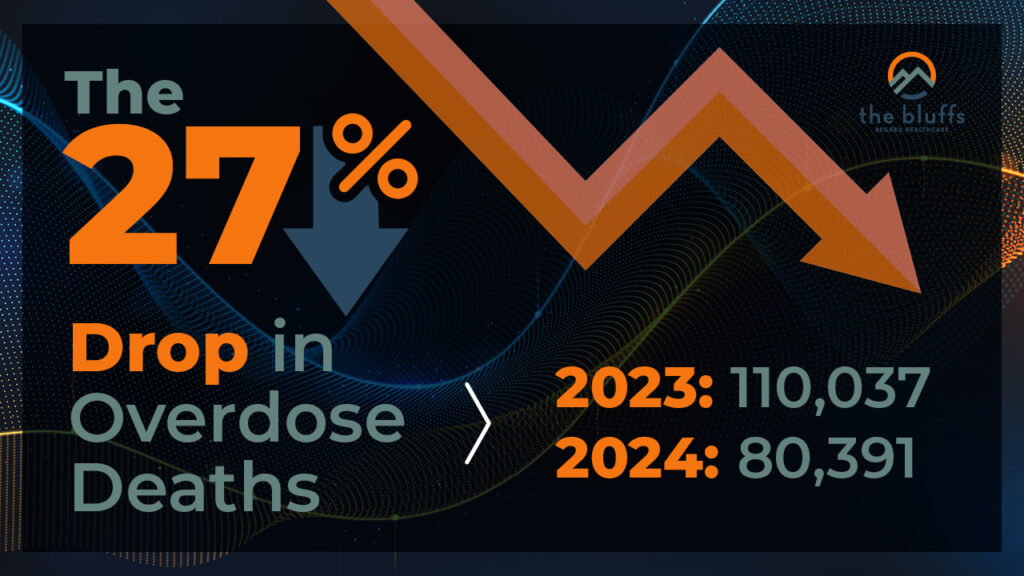For the first time in the modern opioid era, the United States has recorded a historic 26.9% year-over-year decline in drug-overdose deaths, from an estimated 110,037 deaths in 2023 to 80,391 deaths in 2024. This is the largest single-year improvement ever documented by the CDC. Behind those numbers are tens of thousands of parents, siblings, and friends still alive today.
While the progress is encouraging, it underscores an urgent truth: sustained access to evidence-based addiction treatment and harm-reduction tools remains critical for the millions who still struggle with substance-use disorders.
Understanding the Decline
Several intertwined factors drove the 2024 turnaround:
- Medication-Assisted Treatment (MAT) – People with opioid-use disorder who receive methadone or buprenorphine are roughly 50% less likely to die of an overdose than those who go untreated. Expanded MAT capacity—through tele-health flexibility, mobile clinics, and relaxed prescribing rules—helped more patients stay in care.
- Naloxone in every community – Retail pharmacies dispensed more than 2.1 million naloxone prescriptions in 2023—double the 2019 rate. Research suggests one life is saved for about every 15 doses distributed, making widespread naloxone access a cornerstone of overdose-fatality prevention.
- Public awareness and safer drug supplies – Fentanyl test-strip legalization in many states, targeted law-enforcement seizures, and robust public-education campaigns have cut exposure to the most lethal synthetic opioids.
Collectively, these measures reframed addiction as a treatable medical condition, not a moral failing, allowing more Americans to seek help without stigma.

Ohio’s Role in the Recovery Movement
Nowhere is the shift clearer than in Ohio, once among the hardest-hit states. Preliminary 2024 data show Ohio overdose fatalities fell by more than 35%—outpacing the national average. Key elements of Ohio’s strategy include:
- Community-based “quick-response teams” linking overdose survivors to treatment within 72 hours.
- Expanded rural tele-MAT services reaching counties with few addiction specialists.
- Statewide naloxone distribution hubs that put the medication in libraries, fire stations, and even vending machines.
Ohio’s experience proves large-scale, data-driven initiatives can reverse even the steepest overdose trends.
What This Means for Individuals Still Struggling
Every statistic masks a personal battle. The latest numbers reflect better access to care—not a diminished need for it. If you’re currently wrestling with addiction, know that:
- Recovery odds are improving. MAT, counseling, and peer-support programs have never been more effective or widely available.
- Help is broader than one setting. Options range from residential rehab to outpatient therapy, virtual counseling, and physician-supervised MAT. The right fit depends on your unique medical, psychological, and social needs.
The Ongoing Need for Professional Treatment
Addiction profoundly alters brain chemistry, decision-making, and behavior. Self-directed “quitting” rarely provides the medical stabilization, psychological support, and relapse-prevention planning necessary for lasting recovery. A comprehensive program typically integrates:
- Medically supervised detox (when appropriate).
- Individual and group therapy grounded in cognitive-behavioral or trauma-informed practices.
- Family education and support, because recovery is rarely a solo journey.
- Aftercare planning—from sober-living options to alumni groups and tele-health check-ins.
Hope for the Future
The data confirm what recovery advocates have long asserted: evidence-based treatment saves lives. Families can draw hope from the fact that stigma is falling, therapies are improving, and the nation is finally bending the overdose-death curve downward.
Take the First Step Today
If you or someone you love is battling addiction, don’t wait. Effective, compassionate help is within reach.
The Bluffs provides comprehensive addiction treatment in a supportive, healing environment. Call 850-374-5331 today to learn how we can help you start—and sustain—your recovery journey. Your life has value, and help is available.








